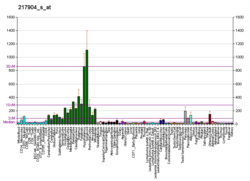Beta-secretase 1, also known as beta-site amyloid precursor protein cleaving enzyme 1, beta-site APP cleaving enzyme 1 (BACE1), membrane-associated aspartic protease 2, memapsin-2, aspartyl protease 2, and ASP2, is an enzyme that in humans is encoded by the BACE1 gene. [5] Expression of BACE1 is observed mainly in neurons and oligodendrocytes. [6]
BACE1 is an aspartic acid protease important in the formation of myelin sheaths in peripheral nerve cells: in mice the expression of BACE1 is high in the postnatal stages, when myelination occurs. [7] The transmembrane protein contains two active site aspartate residues in its extracellular protein domain and may function as a dimer, its cytoplasmic tail is required for the correct maturation and an efficient intracellular trafficking, but does not affect the activity. It is produced as a pro-enzyme, the endoproteolitc removal occurs after BACE leaves endoplasmic reticulum, in the Golgi apparatus. In addition the pro-peptide receives additional sugars to increase the molecular mass. [8] and the tail became a palmitoylated.[ citation needed ]
The BACE1 expression is influenced by the inflammatory state: during AD the cytokines reduce the PPAR1 an inhibitor of BACE1 mRNA.[ citation needed ]








































